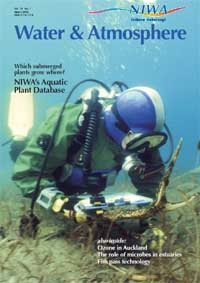
On this page
- Giant squid discovery
- Revamped NIWA website
- Freshwater fish workshop
- Wellington deluge
- Underwater remotely operated vehicle
- NIWA scientist in new international oceanographic programme
- Teacher fellow at NIWA
- River sedimentation survey
- Tsunami Symposium New Zealand 2002
- SOLAS: Surface Ocean–Lower Atmosphere Studies
- Bluenose workshop
Giant squid discovery
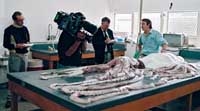
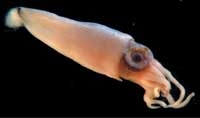
A media conference to mark the first time giant squid had been captured and filmed alive was led by marine biologist Dr Steve O'Shea at NIWA’s Wellington campus on 28 February.
Dr O'Shea and his team caught the juvenile squid, which ranged in size from 9 to 13 mm, off the coast of New Zealand during an expedition that was fully funded by the Discovery Channel, one of America’s largest cable television networks. Previously, the only information known about giant squid came from legends and from dead specimens caught in fishing nets or washed up on shore.
The giant squid (Architeuthis sp.) is the world’s largest invertebrate (up to about 12 m and 350 kg) and has never been seen alive. Dr O'Shea studied more than 60 corpses of adult giant squid before deciding that the best way to find a giant squid and keep it alive would be to find the tiny Architeuthis juveniles.
Giant squid exist in all of the world’s oceans; however, the largest concentration is believed to be near New Zealand. Dr O'Shea led two separate expeditions off the west and east coasts of New Zealand in search of the juvenile squid – one in the winter of 2000 and the other in the summer of 2001. A special fine-meshed net was used to catch the tiny juveniles because their skin is so fragile (just one cell thick).
Although the team kept juveniles of other squid species alive for up to 70 days the giant squid juveniles survived for only about three days. However, Dr O'Shea and his team are determined to one day rear them to adulthood.
The Discovery Channel programme "Chasing giants: on the trail of the giant squid", which was filmed on location with Dr O'Shea, premiered in America on 11 March, and will make its New Zealand television debut on 17 May.
Revamped NIWA website
In the lead-up to its 10th Anniversary, NIWA has totally revamped its corporate website, with the new-look site revealing the depth and breadth of the company.
The opening page now presents current information: media releases, news items, conferences and events and employment opportunities. The remainder of the site covers several broad areas.
- NIWA’s National Centres are designed to deliver information and services directly to the public. Presently there is online access to ‘Climate Monitoring & Prediction’, ‘Fisheries & Aquaculture’, ‘Water Resources’, and ‘Climate–Energy Solutions’, with additional centres planned.
- The site describes NIWA’s core areas of Research & Consultancy – Aquaculture, Atmosphere & Climate, Coast & Oceans, Fisheries, and Freshwater. There is information about NIWA’s capabilities, with emphasis on the company’s expansion to deal with current issues such as Biodiversity & Biosecurity, Biotechnology, Hazards, Pollution, and Resource Management.
- Visit Online Services and, with a couple of clicks, you can see surf conditions at beaches around New Zealand, courtesy of Cam-Era. Or you can check predicted UV and ozone levels, the sea-surface temperatures (SST) around New Zealand and along Australia’s east coast and other climate information. (The popular SST service is widely used for commercial and recreational fishing.) Further free and paid services are being developed.
- Media & Publications takes visitors to an archive of media releases, climate summaries, and online versions of regular publications, such as Water & Atmosphere, Biodiversity Update and Aniwaniwa. A range of charts and posters is available for purchase. A Web Store will be added soon.
- Education & Training includes resources and activities on climate, weather and estuaries, compiled by NIWA’s Royal Society Teaching Fellows in 2001. You’ll also find information about NIWA’s other educational ventures, including sponsorship of regional Science and Technology Fairs.
NIWA’s in-house Web Team created the new website and will maintain it with constant additions of new material and features, and a special focus on interactive services.
The site design complies with recent Government web guidelines for accessibility. For example, scalable font sizes mean that the visually impaired can use their browsers to enlarge the text; talking browsers used by the blind can sensibly read all pages.
The layout is “fluid” and resizes to suit almost any window size. Also we have incorporated “backward compatibility” so that older browsers can accurately access all content, even if they are unable to render the intended presentation.
For further information, contact: Janice Meadows [ [email protected] ] Webmaster, NIWA, PO Box 11115, Hamilton
NIWA workshop on freshwater fish identification
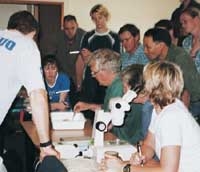
Accurate identification of species is crucial to most freshwater fish studies. But how do you distinguish a Crans bully from a common one? And what about all those new Otago galaxiids – what are their unique features?
In late 2001, NIWA ran two fish identification work-shops to teach participants how to accurately identify freshwater fish. Presented by Bob McDowall (NIWA Christchurch), the workshop covered topics such as:
- how to find and use fish structures (such as fins or scales) to identify fish;
- the use of family, genus and species keys;
- how to correctly preserve fish specimens;
- identification of separate whitebait species (using preserved samples);
- how to access and use the New Zealand Freshwater Fish Database.
The two-day workshop included several practical identification sessions using preserved fish specimens. Each practical session was preceded by a slide show and commentary on the species to be identified. Participants, who included staff from NIWA, the Department of Conservation, regional councils, consultants and universities, then had an opportunity to test their skills using the keys and specimens provided. By the end of the workshop, participants felt confident about using fish structures and keys to identify freshwater fish. The manual provided will continue to provide partici-pants with useful reference material for application of their newly acquired skills.
These workshops were part of a series of freshwater biodiversity identification courses run by NIWA, covering organisms from algae to fish.
So how do you tell a Crans bully from a common one? If you’re not sure, check with NIWA for information about the next freshwater fish identification workshop.
For course information, contact: Lisa Miller [ [email protected] ] NIWA, PO Box 8602, Christchurch Phone +64-3-343 7890 Fax +64-3-343 7891
Wellington deluge
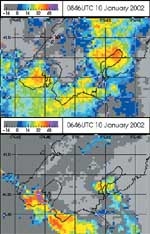
bottom: A snapshot from the Wellington weather radar showing the multi-cellular structure of the thunder cells over the city.
The downpour that inundated Wellington’s central business district on 10 January 2002 could have been significantly worse.
The storm over the city was composed of several small thunder clouds and generated up to 50 mm of rain, most of which fell in an hour. However, a similar complex over the Wairarapa generated over 65 mm. The rainfall was more intense and covered a larger area than that of the city storms.
The extreme rain occurred as rapidly developing thunderclouds passed over the city. The thunder-storms broke up quickly as they moved out over the cooler waters of Cook Strait. Had they moved more slowly, or been more intense like the Wairarapa thunderstorms, Wellington could have experienced even greater rainfall totals.
Events like this are being documented under NIWA’s weather systems programme, with the aim of investigating the processes that lead to our most extreme weather. Detailed knowledge of these processes will lead to an improvement both in the skill and detail of weather forecasts.
Thunderstorms are intense weather systems that have small horizontal scales (often only tens of km2) but have deep and strong updrafts. These updrafts can rise as high as 10 km, and have vertical velocities as strong as 10 m/s – strong enough to hold up heavy hailstones.
Often thunderstorms develop when the air is significantly warmer and moister near the ground than aloft. This is an unstable situation – the warm moist air is less dense than that above it and hence wants to rise. Often a trigger is needed to release this instability. In this case a weak convergence line – where the wind converges and is forced upwards – passed over the warm land-surface of the city. The lifting triggered the development of the thunderstorms. Without this lifting the intense convection that resulted in the thunderclouds would not have developed, as the maximum temperatures over the city were not sufficient by themselves to trigger the convection.
The convergence line, visible in the radar imagery, could not be discerned in satellite imagery, or in larger-scale weather models. We are trying to see whether more detailed modelling of the event could have resolved the conver-gence and predicted the downpour.
For more information, contact: Warren Gray [ [email protected] ] NIWA, PO Box 14901, Wellington Phone +64-4-386 0300 Fax +64-4-386 0574
Underwater remotely operated vehicle
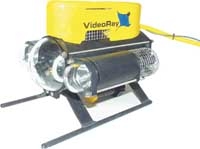
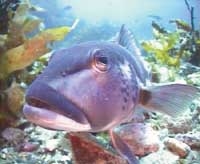
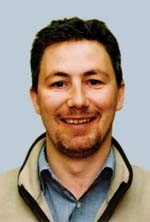
NIWA’s newly acquired VideoRay Remotely Operated Vehicle (ROV) was recently used to introduce non-diving visitors to the underwater scenery and fish of the Kapiti Marine Reserve.
VideoRay ROV, a small (350 x 225 mm), very manoeuvrable unit, with a high-resolution camera capable of operating down to 150 m.
Ten years after the marine reserve was established, the Kapiti Marine Reserve Committee asked NIWA to assist with a public awareness day. NIWA scientist and Chair of the Committee, Ken Grange, suggested a site visit where committee members, Department of Conservation and Ministry of Fisheries staff, and media representatives could watch the underwater life on board a boat in real time. The ROV was to be used to transmit video footage to a screen on the boat.
Ken Grange and Rob Stewart launched the ROV at four sites within the reserve. Viewers on the boat were constantly amazed at both the variety of fish life and the numbers of commonly caught species such as blue cod. The ROV, being small and inconspicuous, appears not to disturb the fish in the same way that divers do. Some of the excellent video footage that was shot has been used at subsequent meetings to inform the public of the recovery of fish populations in the reserve.
Several other current NIWA research projects use the ROV, including an assessment of the numbers and types of fish living within mussel farms in the Marlborough Sounds, and characterising biological habitats in deep water (> 30 m), where bottom time is limited for divers.
For further information, contact: Ken Grange [ [email protected] ] NIWA, PO Box 893, Nelson Phone +64-3-548 1715 Fax +64-3-548 1716
NIWA scientist in new international oceanographic programme
Dr Julie Hall from NIWA, Hamilton, is to chair an international team of 15 scientists charged with developing a science and implementation plan for the new international oceanographic programme Ocean Biogeochemistry and Ecosystems. This programme is part of the second phase of the International Geosphere–Biosphere Programme (IGBP), which focuses on understanding and predicting the impacts of global change on the Earth’s system. Understanding the response of the oceans to global change is critical as the oceans cover 70% of the Earth’s surface and play a major role in regulating its climate and biogeochemical cycles.
The new programme will address three broad, overarching questions.
- What controls the time-varying biogeochemical state of the ocean system and how will it respond to global change?
- How will marine food webs respond to global change?
- How does carbon accumulation in the ocean respond to global environmental change?
The international team will be responsible for preparing a draft plan for the programme, and then holding an international conference in January 2003 to get comments from the wider oceanographic community.
For further information contact: Julie Hall [ [email protected] ] NIWA, PO Box 11115, Hamilton Phone +64-7-856 7026 Fax +64-7-856 0151
Teacher fellow at NIWA
A recent temporary addition to the staff at NIWA, Hamilton, is Keith Hartle, Royal Society Science Teacher Fellow. Keith is from Dargaville High School, Northland, where he has been teaching and managing the science department for the last 16 years. He will be working from his home base in Dargaville and at NIWA, Hamilton, on projects related to lake water quality and oceanography. Both of these follow personal interests, gained through sailing on the freshwater dune lakes and fishing off the west coast beaches of Northland. The projects have been chosen because they focus on the integration of scientific disciplines.
Keith’s studies will involve monthly sampling of the Kai Iwi lakes in Northland to assess their nutrient status and physical properties. On the marine side of things Keith will be involved with the Sea and Learn education programme as the teacher onboard (see Water & Atmosphere 7(4): 4; 8(3): 4). He will also work with Phil Sutton and Basil Stanton to investigate ways of bringing the Argo programme into the classroom (see Water & Atmosphere 9(4): 25). Argo incorporates many ideas taught in the classroom but not necessarily all in one curriculum package. Keith was especially interested in Argo because it provided an opportunity to work on a project that integrates many different concepts and is related to climate, which is very topical at present.
River sedimentation survey

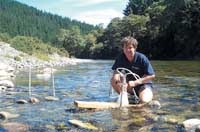
Excessive sedimentation of streams and rivers associated with human land-use practices (for example, dairying, forestry, urban development) is currently a major issue in many New Zealand regions. Suspended sediment problems are highly visible, and the effects on river ecosystems are relatively simple to measure. In contrast, the effects of deposited sediment on river health and biodiversity have been poorly studied.
As part of NIWA’s FRST-funded programme River Ecosystems and Land Use Interactions, a survey of 32 river sites around New Zealand has recently been completed to assess the effects of sedimentation on a particularly sensitive component of river ecosystems – the hyporheic zone. The hyporheic zone is the area beneath the streambed where surface and groundwaters mix. This zone plays an important role in rivers, acting like the filter in an aquarium. It also forms an important extension of the habitats of both benthic (surface dwelling) and phreatic (groundwater dwelling) invertebrates. The importance of the hyporheic zone is related to the degree of connection with surface waters, and this is where the issue of sedimentation becomes important. Deposited sediment can break the connection between the surface and the hyporheic zone, causing a loss of invertebrate habitat (and associated biodiversity) as well as overloading the natural filtering system within the riverbed (see Why rivers get clearer as they flow downstream in this issue).
In one of the most extensive hyporheic surveys carried out anywhere in the world, we measured the levels of fine sediment on the streambed surface and at 30 cm down in the bed (that is, the hyporheic zone). In addition, we sampled interstitial invertebrates and measured various water chemistry variables. Located from East Cape to Marlborough, the 32 sites covered a wide range of geological types and land-use conditions. All sites are associated with long-term water quality, flow and benthic invertebrate datasets managed by NIWA, the Cawthron Institute in Nelson, and Landcare. It is hoped that the addition of hyporheic information to these datasets will allow us to more fully assess the consequences of sedimentation on the health of river ecosystems.
For further information, contact: NIWA, PO Box 11115, Hamilton Phone +64-7-856 7026 Fax +64-7-856 0151
Tsunami Symposium New Zealand 2002
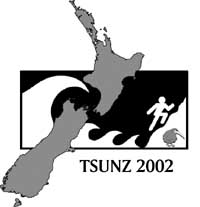
‘Saving lives’ was the theme of the Tsunami Symposium New Zealand 2002 (TSUNZ 2002), held at Lindale Conference Centre in Paraparaumu on 7–8 February 2002. The meeting brought together scientists and engineers from throughout New Zealand who work in tsunami research and tsunami hazard assessment. The aims were:
- to review the current state of knowledge of tsunami and tsunami effects in New Zealand;
- to identify any gaps in knowledge and resources (such as bathymetry and topography) where further research could facilitate awareness, preparedness and mitigation of tsunami – and hence save lives.
Underlying TSUNZ 2002 is the recognition that the best understanding of tsunami and tsunami impact comes from collaboration of researchers from many disciplines. To ensure that the information reaches the general community, researchers need to collaborate with end-users, such as Emergency Managers, Territorial Planners and the insurance industry.
Professor Lori Dengler, a member of the Steering Committee of the US National Tsunami Hazard Mitigation Program, gave the keynote address. Professor Dengler has participated in several International Tsunami Field Survey Teams, including those in Papua New Guinea (1998) and Peru (2001). She has also reviewed the creation of the Hazards Mitigation Program, and has worked in tsunami mitigation and on current efforts to create a more robust tsunami warning system.
TSUNZ 2002 was jointly sponsored by NIWA, the Institute of Geological and Nuclear Sciences (GNS), and the Earthquake Commission (EQC). The co-convenors were Dr Roy Walters (NIWA), Dr James Goff (GeoEnvironmental Consultants), and Gaye Downs (GNS).
For further information, contact: Roy Walters [ [email protected] ] NIWA, PO Box 8602, Christchurch Phone +64-3-348 8987 Fax +64-3-348 5548
SOLAS: Surface Ocean–Lower Atmosphere Studies
SOLAS is a new international research initiative sponsored by the International Geosphere–Biosphere Programme (IGBP) and other international bodies. The studies will quantify interactions between the ocean and the atmosphere around the globe in order to learn more about how this coupled system affects and is affected by climate and environmental change. There is a focus on the exchange of climatically relevant trace gases such as carbon dioxide and dimethylsulfide.
SOLAS-ANZ (Australia/New Zealand) is one of several regional or national programmes being developed. At a workshop held in Wellington in March 2002, NIWA specialists in ocean ecosystems, gas exchange and atmospheric chemistry met to develop plans for new interdisciplinary studies over the next few years. The research will aim to quantify the role played by the marine biosphere in determining the composition of the atmosphere in our region. The first experiments will make direct measurements of the exchange of gases during a phytoplankton bloom.
We already know that phytoplankton (microscopic plants) not only remove carbon dioxide from the atmosphere as they grow but also can produce organic compounds, leading to the release of volatile gases such as dimethylsulfide into the atmosphere. Here, they are transformed into small particles (aerosols). Both these processes influence climate. However, many of the interactions and feed-backs between atmospheric composition and the marine biosphere are poorly understood. It is vital that we understand more and develop our ability to predict how these processes may respond to global warming and also affect future climate.
Following similar meetings in Australia, experts from both countries will develop the regional science plan further at a workshop and special session of the Western Pacific Geophysics Meeting being held in Wellington in July 2002.
For more on IGBP, check: www.igbp.kva.se; and on SOLAS: www.uea.ac.uk/env/solas
For further information about SOLAS-ANZ, contact: Mike Harvey [ [email protected] ] NIWA, PO Box 14901, Wellington Phone +64-4-386 0300 Fax +64-4-386 0574 or Philip Boyd [ [email protected] ] or Neil Tindale [ [email protected] ]
Bluenose workshop
Bluenose (Hyperoglyphe antarctica) supports a target line fishery and forms a major bycatch of midwater trawling in northern and central New Zealand waters. Previous stock assessments have indicated that catch-effort data may not measure abundance, particularly from the trawl fishery, where bluenose bycatch is actively avoided. Quantitative line-fishing surveys may be suitable for determining the relative abundance of bluenose and other fish. This is the topic of a joint NIWA, MFish and the New Zealand Seafood Industry Council (SeaFIC) workshop being held at NIWA in Nelson in April 2002.
The workshop is bringing together industry technical expertise and experience on fishing methods and fishing grounds, with research input from Australian and New Zealand scientists and fishery managers. As bluenose also occurs in Australia, international interest in the meeting has been high. Six participants from Australia and the USA will join 15 from New Zealand. Guest speakers include Dr Mike Sigler (US Fisheries Service, Alaska) who will describe recent US research in the Alaskan sablefish line fishery, and Dr Ian Ball (Australian Antarctic Division) who will talk about the software program “Fish Heaven”. The outcome of the workshop will be an evaluation of the potential of line-fishing surveys for stock assessment of bluenose and other species.
For more information, contact the workshop convenor: Ron Blackwell [ [email protected] ] at NIWA, PO Box 893, Nelson Phone +64-3-548 1715 Fax +64-3-548 1716
